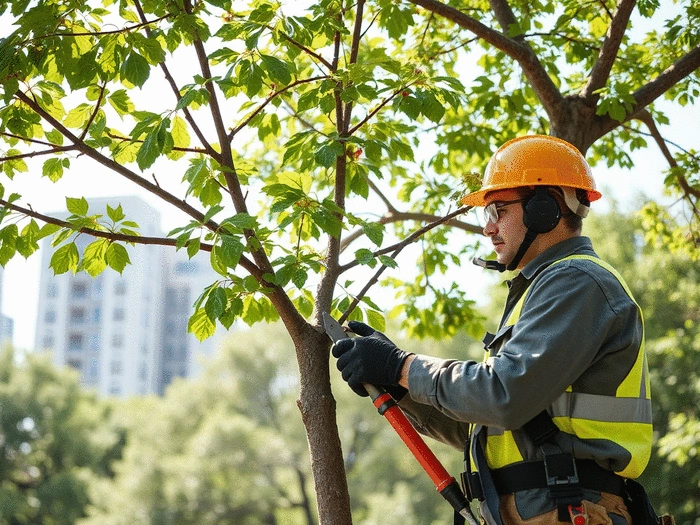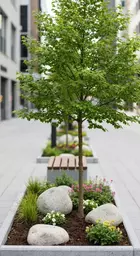Pruning City Trees: Timing & Tips

Posted on: 2025-08-08
By: Keira Vallejo
Did you know that seasonal pruning is essential not only for the aesthetic appeal of urban trees but also for their overall health and resilience? Understanding this practice can transform your perspective on tree care and its impact on our city landscapes.
What You Will Learn
- Seasonal pruning enhances tree health by removing dead or diseased branches, promoting better air circulation and light penetration.
- Proper pruning techniques contribute to the structural integrity of trees, helping them withstand adverse weather and grow stronger in urban environments.
- Healthy urban trees play a crucial role in improving air quality, reducing noise pollution, and supporting local wildlife.
- Familiarity with pruning techniques, such as thinning, reduction, and deadwooding, is vital for effective tree care and maintaining urban greenery.
- Recognizing signs of tree distress, such as discoloration and soft bark, can help in early identification and management of diseases and pests.
- Sanitizing pruning tools and making clean cuts are essential practices to minimize disease spread and promote quicker healing in trees.
- A balanced approach between structural and aesthetic pruning enhances both the form and beauty of trees in urban landscapes.
Key Benefits of Seasonal Pruning for Urban Trees
Seasonal pruning not only enhances tree health but also impacts urban ecosystems positively. Below is a visual representation of the key benefits and techniques associated with seasonal pruning.
Tree Health Improvement
Enhances growth and structure by:
- Removing dead wood
- Improving air circulation
- Promoting sunlight penetration
Ecosystem Benefits
Healthy trees contribute to:
- Cleaner air
- Reduced noise pollution
- Support for diverse wildlife
Community Engagement
Fosters community spirit through:
- Local tree care initiatives
- Awareness of urban greenery
- Stronger neighborhood bonds
Pruning Techniques
Essential methods for effective pruning:
- Thinning: Improves light and air
- Reduction: Maintains shape
- Deadwooding: Enhances overall health
Understanding the Importance of Seasonal Pruning for Urban Trees
Have you ever wondered why some trees seem to flourish in the city while others struggle? A big part of that answer lies in seasonal pruning. This crucial practice helps maintain the health of urban trees, allowing them to thrive amid the hustle and bustle of city life. Seasonal pruning isn’t just about aesthetics; it plays a vital role in keeping our urban forests healthy and vibrant.
Pruning at the right time can enhance tree growth, improve structural integrity, and reduce the risk of disease. By removing dead or diseased branches, we can promote better air circulation and sunlight penetration, which is essential for a tree's overall health. In my experience as an urban forestry expert, I've seen how a little care can go a long way in transforming our city landscapes!
When considering seasonal pruning, it's also important to consider the benefits of professional tree care, ensuring your urban trees receive the best possible attention. This not only enhances their health but also contributes to the overall beauty and ecological balance of our cities.
The Role of Pruning in Maintaining Tree Health
When it comes to tree care, pruning is one of the most important tasks you can undertake. It helps to ensure that trees remain healthy by:
- Removing dead or diseased wood that can harbor pests.
- Encouraging new growth by opening the canopy.
- Improving air circulation, which helps prevent fungal infections.
All these factors contribute significantly to the overall vitality of the tree. In urban environments where trees often face stress from pollution and limited space, a well-timed pruning session can make all the difference. Think of it as a way to give our leafy friends the boost they need to thrive!
How Pruning Contributes to Structural Integrity and Growth
Pruning not only focuses on the immediate health of the tree but also its long-term stability. By maintaining a strong structure, we can help trees withstand adverse weather conditions like strong winds and heavy snowfall. This is particularly crucial in urban settings where space is often limited, and trees may have to share resources with buildings and other vegetation.
In my work with the Urban Canopy Blog, I've highlighted how proper pruning can lead to better growth patterns. A tree that is regularly pruned tends to develop a robust structure, which supports healthier growth and minimizes the risk of branch failure. If you’ve ever seen a tree leaning awkwardly or struggling to grow, it’s often a sign that it hasn’t received the attention it needs!
Did you know that urban trees contribute significantly to our mental well-being, reducing stress and improving overall quality of life? Regular pruning ensures they remain healthy and vibrant, enhancing these benefits.
The Impact of Pruning on Urban Ecosystems
The benefits of pruning extend beyond individual trees; they ripple through the entire urban ecosystem. Healthy trees contribute to cleaner air, reduced noise pollution, and lower temperatures in city environments. A well-maintained tree canopy can also support diverse wildlife, including birds and beneficial insects, making our cities more vibrant.
Moreover, by engaging in pruning activities, we foster a sense of community. When neighbors come together to care for their local trees, it enhances connections and raises awareness about the importance of urban greenery. So, next time you see a tree in need of a trim, consider gathering some friends for a pruning session—it could be the start of something beautiful!
Pruning Techniques for Optimal Tree Care
Knowing the right techniques is crucial for effective pruning. Here are some essential methods that can help:
- Thinning: Removing selected branches to improve light penetration and air circulation.
- Reduction: Shortening branches to decrease their length while maintaining their natural shape.
- Deadwooding: Removing dead or dying branches to enhance tree health.
Each technique plays a vital role in ensuring that urban trees not only look good but also maintain their health and resilience. I always encourage community members to familiarize themselves with these methods, as they lay the foundation for proper tree care!
FAQs About Seasonal Pruning
- Why is seasonal pruning important for urban trees? Seasonal pruning is essential for maintaining the health of urban trees, promoting growth, improving structural integrity, and reducing the risk of disease.
- What are the key benefits of seasonal pruning? Key benefits include enhancing tree growth, improving air circulation and sunlight penetration, reducing disease risk, and contributing to the overall health of the urban ecosystem.
- What are the main pruning techniques to know? The main pruning techniques are thinning, reduction, and deadwooding, each playing a vital role in ensuring the health and resilience of urban trees.
- How does pruning contribute to structural integrity? Pruning helps maintain a strong structure, enabling trees to withstand adverse weather conditions and share resources effectively in urban settings.
- What role does pruning play in disease prevention? Pruning helps prevent the spread of pathogens, reduces moisture buildup that can lead to fungal infections, and encourages new growth to help trees recover from stress and disease.
Essential Pruning Techniques for Tree Health
As we dive deeper into pruning, let’s look at some essential techniques for tree health:
- Clean Cuts: Always use sharp, clean tools to make smooth cuts. This helps to minimize damage and reduce the likelihood of disease.
- Cutting at the Right Angle: Make sure to cut at a 45-degree angle, which promotes healing and prevents water accumulation.
- Follow the 1/3 Rule: Never remove more than one-third of a tree's foliage at once to avoid stress.
These techniques will not only ensure the health of the tree but also help you feel more confident in your pruning skills. Remember, every cut counts when it comes to keeping our urban forests healthy!
Understanding Structural and Aesthetic Pruning
Pruning can serve both structural and aesthetic purposes, and understanding the difference is key. Structural pruning is all about improving the tree's form and strength. It involves removing branches that could compromise the tree’s stability and ensuring a well-balanced shape. On the other hand, aesthetic pruning focuses on the tree's appearance, enhancing its visual appeal in the urban landscape.
In my experience, a good balance of both types leads to thriving trees that are not only functional but also beautiful. So, whether you’re maintaining a majestic oak or a delicate cherry blossom, consider how both structural and aesthetic prunings can enhance their health and presence in your neighborhood!
Understanding the importance of choosing the right trees for your climate can enhance the effectiveness of pruning efforts, ensuring healthier and more resilient urban greenery.
Pro Tip
Did you know? Timing is crucial when it comes to pruning urban trees. The best time to prune most trees is during their dormant season, typically late winter to early spring. This minimizes stress on the tree and promotes vigorous growth in the spring. Additionally, always observe local regulations regarding tree care, as some municipalities may have specific guidelines to protect urban greenery.
Managing Tree Health: Disease Prevention Through Pruning
Keeping our urban trees healthy is crucial, especially as they face various threats from pests and diseases. When we prune correctly, we can not only enhance the tree's overall health but also reduce the risks of these issues arising. Regular pruning helps us discover and address early signs of trouble, which is a vital part of maintaining the lush urban canopies we love.
Have you ever noticed an unusual discoloration in your tree's leaves? Or perhaps some branches look a bit wilted? Identifying these issues early can make a significant difference. By routinely checking your trees and implementing proper pruning techniques, we can effectively manage common tree diseases like powdery mildew and root rot.
Recognizing Signs of Tree Disease and Pest Issues
Understanding the signs of tree distress can help us act quickly. Some common signs to look out for include:
- Discolored leaves or premature leaf drop
- Visible holes or frass (insect waste) in the bark
- Soft or mushy bark that appears to be peeling
- Excessive sap production
These symptoms indicate potential disease or pest issues that could be harming your tree. When we prune effectively, we can reduce the prevalence of these problems and help our trees recover. It's a good idea to consult local resources or even reach out to Urban Canopy Blog for guidance tailored to your specific tree species.
How Pruning Can Help Manage Common Tree Diseases
Pruning plays a vital role in disease management. Here’s how it helps:
- Removing diseased branches prevents the spread of pathogens.
- Improving air circulation reduces moisture buildup, which can lead to fungal infections.
- Encouraging new growth helps trees recover from stress and disease.
By incorporating these practices into your seasonal care routine, you can significantly enhance your tree's resilience against various diseases. Remember, it’s not just about cutting branches; it’s about fostering health and vitality!
Pruning Tips to Minimize Disease Spread
To keep your trees healthy, consider these effective pruning tips:
- Always sanitize your tools before and after pruning to avoid transferring pathogens.
- Make clean cuts to minimize the size of wounds, which helps the tree heal faster.
- Apply wound sealants if necessary, but only for larger cuts as a general practice.
Implementing these tips ensures that our trees are not only well-maintained but also protected from potential health threats. Let’s safeguard our urban forests!
Just as crucial as pruning is understanding essential tree watering methods, which ensures your urban trees receive adequate hydration, promoting overall health and resilience.
Wound Sealing Techniques and Their Importance
While sealing wounds isn’t always necessary, it can be beneficial in certain situations. For example, when dealing with large cuts, a proper sealing technique can help prevent decay and pest infestations. However, it’s crucial to choose the right products, as some sealants can hinder natural healing processes.
Make sure to use a quality sealant and apply it correctly to bolster your tree's defenses. Your meticulous care will pay off in the long run as your trees thrive in our urban landscapes!
Pest Management Strategies for Urban Trees
Managing pests is just as important as managing diseases. Here are some strategies to keep in mind:
- Regularly inspect trees for signs of pests.
- Encourage beneficial insects that prey on harmful pests.
- Use organic pest control methods whenever possible to protect the ecosystem.
We can create vibrant habitats for wildlife while keeping our trees healthy. At Urban Canopy Blog, we believe that a proactive approach to pest management ensures healthier, happier trees for everyone in the community!
Recap of Key Points
Here is a quick recap of the important points discussed in the article:
- Seasonal pruning is essential for maintaining the health of urban trees, promoting growth, and reducing disease risk.
- Pruning techniques such as thinning, reduction, and deadwooding are vital for enhancing tree health and structure.
- Proper pruning contributes to the overall urban ecosystem by improving air quality, reducing noise, and supporting wildlife.
- Recognizing signs of tree disease and pest issues early can be crucial for effective management and prevention.
- Sanitizing tools and making clean cuts help minimize disease spread and promote faster healing.
- Engaging in community pruning activities fosters connections and enhances awareness about urban greenery.
 As urban environments evolve, the resilience of trees becomes increasingly critical in combating cli
As urban environments evolve, the resilience of trees becomes increasingly critical in combating cli
 What if the key to combating urban food insecurity lies in our own backyards? Urban fruit trees not
What if the key to combating urban food insecurity lies in our own backyards? Urban fruit trees not
 Urban environments are often described as concrete jungles, but they can also be vibrant ecosystems
Urban environments are often described as concrete jungles, but they can also be vibrant ecosystems